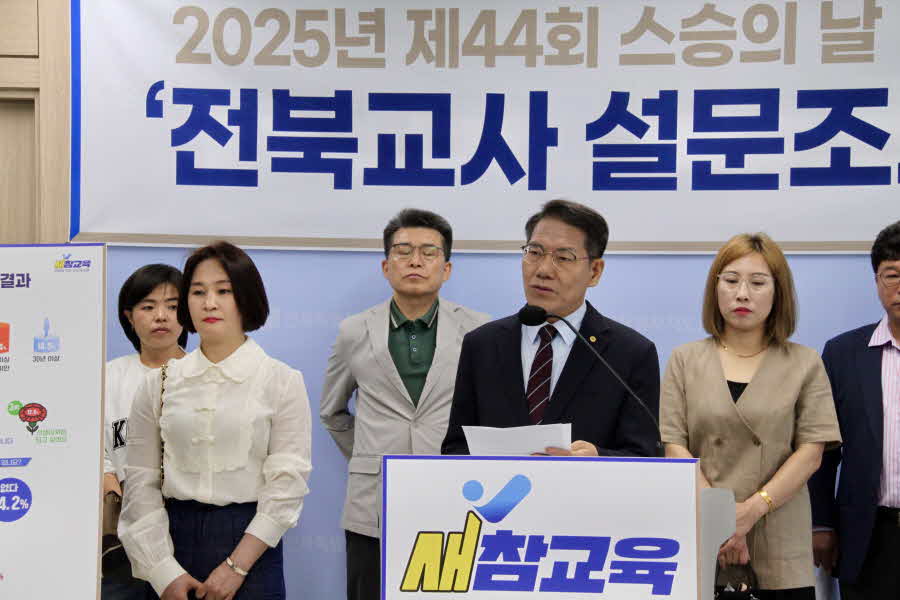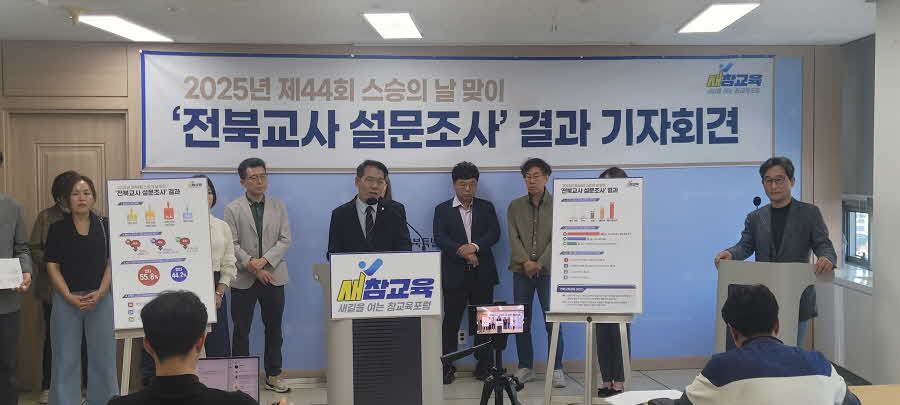2025년 제44회 스승의 날을 맞아 새길을 여는 참교육포럼(이하 새참교육. 대표 노병섭)은 전북 지역 교사 303명을 대상으로 설문조사를 실시하고, 그 결과를 5월 14일 전북교육청 기자실에서 발표했다. 이번 조사는 교육 현장의 실태와 교사들의 현실적 목소리를 드러내기 위한 목적이다.
설문에 응답한 교사들 중 55.8%는 최근 3년 이내 퇴직 또는 이직을 고민한 경험이 있다고 답했다. 퇴직 고민의 주요 사유는 학생 생활지도의 어려움(49.1%)과 과도한 행정업무(35.5%)였다. 교사들은 수업 준비를 퇴근 후에야 할 수 있으며, 수업 중 집중이 어려운 학생들, 성희롱 발언, 예고 없는 돌발 행동 등으로 인해 교실 수업 자체가 붕괴되고 있다고 응답했다. 이에 대해 새참교육은 교사의 희생만으로 교실이 유지될 수 없는 상황이라며, 수업이 가능한 교실을 위한 현장 교사들의 목소리가 존중받고 교육 환경 및 제도 개선이 필요하다는 입장이다.
현직 교육감에 대한 평가도 매우 낮게 나타났다. 서거석 전북교육감에 대해 ‘만족’ 또는 ‘매우 만족’한다고 응답한 비율은 3.6%에 불과했으며, ‘불만족’ 또는 ‘매우 불만족’은 77.9%에 달했다. 불만족의 주된 이유는 ‘교사 의견을 무시한 일방적 정책 추진’(80.1%), ‘업무 폭증’(51.3%), ‘사법 리스크로 인한 청렴도 하락’(31.4%) 순으로 나타났다. 특히 초등 총괄평가에 대해 초등교사의 75.2%가 ‘불만족’ 또는 ‘매우 불만족’이라고 응답하였으며, 미래교육 정책과 교원 인사 전보제도에 대해서도 각각 54.4%, 57.1%가 부정적인 평가를 내렸다.
이 조사 결과에는 전북교육청의 주요 사업 대부분이 교사들로부터 낮은 평가를 받고 있는 것으로 확인되었다. 미래교육 정책, 청렴도, 연구학교 확대, 공모사업 확대, 교원 인사제도 등 핵심 분야에서 모두 ‘만족’ 응답은 10% 전후에 그쳤고, ‘불만족’ 및 ‘매우 불만족’ 비율은 50%를 넘는 경우가 다수였다. 이는 교육청 정책이 교육적 실효성보다는 실적 중심으로 운영되며, 교사의 의견이 실질적으로 반영되지 않고 있다는 교사들의 인식을 반영하는 것으로 해석된다.
설문에 응한 교사들은 교육 당국이 우선적으로 추진해야 할 정책으로 ‘교사 의견 반영을 위한 제도적 장치 마련’(58.4%)과 ‘교육활동 보호를 위한 법적·제도적 장치 강화’(49.5%), ‘교사 정원 확보’(38.6%) 등을 꼽았다. 특히 교원 복지 향상을 위한 요구에서는 ‘교원평가 폐지 및 성과급 수당화’가 89.0%로 가장 높게 나타났으며, ‘교사 정원 확보’(60.8%)와 ‘안식년 및 퇴직자 유급휴가제’(40.9%) 등의 요구도 높았다.

(사진 : 설문조사에 대해 답변하는 노병섭 대표)
새참교육은 전북 교사들이 여전히 아이들과 진심으로 마주하고 있으며, 자신의 삶으로 가르치고자 하는 신념을 지키고 있다고 강조했다. 그러나 이들의 교육 활동이 지속 가능하기 위해서는 사회의 실질적인 지지와 제도적 보장이 뒤따라야 함을 강조하며, 교육청과 정부, 정치권의 각성을 촉구했다.
이번 설문조사는 약 2,000여 명의 전북 지역 교사를 모집단으로 하여 실시되었으며, 총 303명이 응답에 참여해 응답률은 약 15%로 집계되었으며 응답률이 높은 편이다.
일반적으로 온라인 기반의 자발적 응답 방식으로 진행되는 사회조사에서 10% 전후의 응답률은 통상적인 수준으로 간주되며, 이보다 높은 응답률은 현장 관심도나 이슈 민감도를 반영하는 지표로 해석된다.
응답률이 높은 것에 대해 교육청 관계자의 신뢰성을 문제삼는 의견도 있었다. 설문 응답률이 상대적으로 높았다는 점에 대해 응답의 대표성과 동기 유발 요인에 대한 의문이 제기되기도 했다. 그러나 사회조사 방법론 측면에서 응답률은 단순한 수치 이상의 의미를 지닌다. 조사 주체에 대한 신뢰와 정체성 인식에 따라 크게 달라진다(Groves & Couper, 1998).
특히 조사 주체가 교사 출신으로 구성된 교육단체이거나, 교사들의 실질적 고민을 반영할 수 있는 채널로 인식될 경우, 응답자의 자발적 참여율은 제도권 기관이 교육청이 주관하는 조사보다 높게 나타나는 경향이 있다. 이는 ‘조사자가 응답자와 유사한 사회적 배경이나 이해를 공유한다고 인식되는 경우, 정서적 동일시가 강화되며 응답 동기가 유의미하게 상승하는 것으로 나타난다’(이태훈·김기헌, 2013).
또한, 설문 방식이 강제성이 없는 온라인 개방형 조사였음에도 불구하고 특정 시기에 이처럼 높은 비율의 교사들이 응답에 참여했다는 사실은, 단순한 반응 이상의 집단적 문제의식과 의견 개진의 필요성을 드러내는 정성적 지표로도 해석될 수 있다. 이는 통계적 유의성과 더불어 교육정책 수립에 앞서 교육 당국이 경청해야 할 필요가 있다.
To mark the 44th Teachers’ Day in 2025, the education reform group Saecham Gyoyuk (literally, “True Education Forum for a New Path,” hereafter referred to as Saecham) conducted a survey of 303 teachers in the North Jeolla Province (Jeonbuk) and released the results on May 14 at a press conference held at the Jeonbuk Provincial Office of Education. The survey aimed to capture the realities of the classroom and amplify teachers’ voices on the ground.
Among the respondents, 55.8% said they had considered resigning or leaving the profession within the past three years. The most cited reasons were difficulties with student guidance (49.1%) and excessive administrative workload (35.5%). Teachers reported that they could only prepare lessons after hours and that classroom environments were increasingly chaotic, with students sleeping, completing cram school homework, or even engaging in inappropriate and disruptive behavior during lessons. Saecham emphasized that teachers’ personal sacrifices alone can no longer sustain the classroom and called for systemic improvements to ensure viable teaching and learning conditions.
The assessment of Superintendent Seo Geo-seok’s leadership was overwhelmingly negative. Only 3.6% of teachers expressed satisfaction with his tenure, while 77.9% responded with dissatisfaction or strong dissatisfaction. The most common criticisms were his unilateral policymaking without teacher input (80.1%), the increase in teachers’ administrative burdens (51.3%), and the decline in institutional integrity due to the superintendent’s legal risks (31.4%). Dissatisfaction was particularly high among elementary school teachers, with 75.2% expressing disapproval of the province’s comprehensive assessment policy. Similarly, discontent was strong regarding future education policies and teacher transfer regulations, with 54.4% and 57.1% of respondents expressing dissatisfaction, respectively.
Survey results showed that nearly all key initiatives under the current provincial administration received low marks from teachers. Approval ratings for core programs—such as future education, integrity of the education office, research school expansion, competitive project funding, and teacher transfer systems—hovered around 10%, while disapproval exceeded 50% in most categories. These results reflect a widespread perception among educators that policies are being driven by performance metrics rather than educational efficacy, with little regard for teacher perspectives.
When asked what policy changes should be prioritized, respondents highlighted the establishment of institutional mechanisms to reflect teacher input (58.4%), stronger legal protections for educational activities (49.5%), and increased teacher staffing (38.6%). Regarding welfare and working conditions, an overwhelming majority (89.0%) supported abolishing teacher performance evaluations and converting bonuses into fixed compensation. Demands for sabbatical and paid retirement leave also drew strong support (40.9%).
Despite the challenges, Saecham noted that teachers in Jeonbuk remain dedicated to their students, striving to educate with sincerity and personal integrity. However, they emphasized that sustaining this commitment will require concrete institutional and societal support, calling on the provincial office, the Ministry of Education, and lawmakers to take responsibility for restoring the dignity of the teaching profession.
The survey was conducted among an estimated population of 2,000 teachers in the region, with a response rate of approximately 15%. This is considered relatively high for voluntary online surveys. In survey methodology, a 10% response rate is often seen as standard for online participation, and a higher rate suggests heightened engagement or issue sensitivity among the target group.
Some officials questioned the validity of the response rate, raising concerns about sampling motivation and representativeness. However, from a methodological perspective, response rates are influenced by more than just numbers—they also reflect respondents’ trust in the survey sponsor and their perceived relevance of the survey content. As Groves and Couper (1998) argue, response rates are significantly affected by the social credibility and perceived proximity of the surveyor.
In particular, when the survey is conducted by a group composed of former teachers or perceived as genuinely representing teachers' interests, response rates are likely to be higher than those achieved by formal institutions such as education offices. This is supported by findings from Korean scholars Lee Tae-hoon and Kim Ki-heon (2013), who concluded that “when respondents believe the surveyor shares their background or concerns, emotional identification increases and so does the likelihood of participation.”
Moreover, the fact that this was a voluntary, non-compulsory online survey, yet still garnered such participation during a busy school term, may be interpreted not just as a reaction to a specific issue, but as a collective expression of professional urgency. This adds qualitative weight to the quantitative data and reinforces the need for educational policymakers to treat this feedback as both statistically valid and socially imperative.


